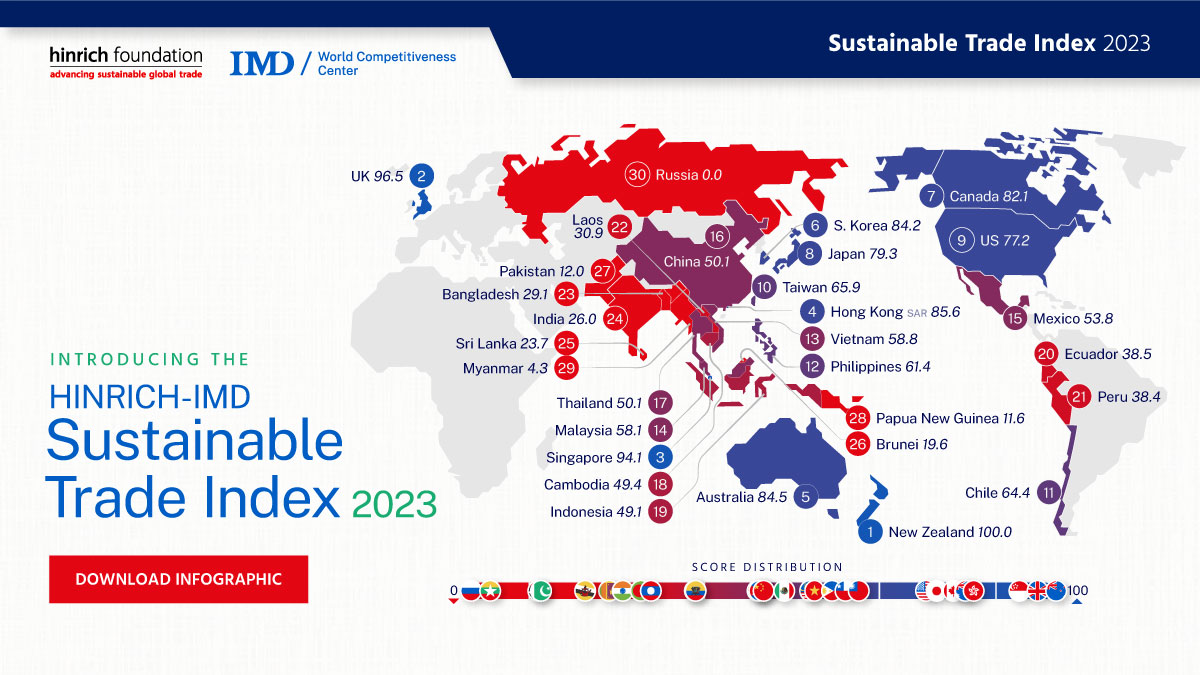Published 24 October 2023
The Sustainable Trade Index 2023 ranks 30 key economies including all the Asia-Pacific, the United States, China, the United Kingdom, and Latin America, against a framework of 71 measures of economic, societal, and environmental policies. We asked data artists Visual Capitalist to illustrate some of the key findings and themes from this year's rankings.
(Text by Chuin Wei Yap and Kathryn Dioth)
At the Hinrich Foundation, we believe global trade is essential not just to economic growth, but to societal prosperity.
On superficial analysis, trade doesn’t always translate to a large or pivotal necessity for big economies, especially those inclined to or capable of sustaining some level of autarky. For smaller economies, it is often more transformative in uplifting livelihoods, peoples, and nations. But, for economies both large and small, trade has the ability to supercharge growth.
This isn’t always a net positive for societies. Untrammeled economic growth, if mismanaged or neglected by policy, often results in widening inequalities and environmental degradation that eventually cost the trading economies in negative externalities just as much as it gained from revenue.
As we launch today the 2023 edition of our Hinrich-IMD Sustainable Trade Index, we remind ourselves again that the advancement of trade is the advancement of sustainability goals. The index ranks 30 key economies including all the Asia-Pacific, the United States, China, Britain, and parts of Latin America, against a framework of 71 measures of economic, societal, and environmental policies. In effect, it acts as a blueprint for governments, businesses, and communities to shape strategies and policies that integrate their conduct of global trade in ways that promote the prosperity and sustainability of their economies.
As Visual Capitalist shows in this illustration, the first instalment in a series that will showcase the findings of the 2023 Sustainable Trade Index, New Zealand tops the chart in getting such policies right. The world’s two largest economies, America and China, sit somewhere in the mid-tier, while Myanmar and Russia are getting most of these policies wrong.
These findings come as the global trading system is experiencing an era of the most severe geopolitical and economic fragmentation in 70 years. Protectionist trade policies are being implemented under the guise of responding to the headwinds of post-pandemic inflation and geopolitical tensions. Globalization is transmogrifying in ways that no longer translate to common progress.
Through the STI, we are measuring how the world is changing. Non-tariff barriers have risen; trade costs are on the rise, with worsening logistics performance and rule of law. We are seeing negative changes in societal indicators such as forced labor and trade in goods at risk of modern slavery. Environmental indicators showing negative trends, such as wastewater treatment and energy intensity, also represent challenges in need of collaborative solutions.
On the bright side, most STI economies are increasingly relying on renewable sources of energy, and many have reduced their air pollution levels and seen a rise in the net inflow of foreign direct investment.
We want the Sustainable Trade Index to guide policy toward an effective management of trade, while expanding and facilitating it, to promote our sustainability as a human race. What we learn from it should help to set us on a path back to sustainable globalization.
© The Hinrich Foundation. See our website Terms and conditions for our copyright and reprint policy. All statements of fact and the views, conclusions and recommendations expressed in this publication are the sole responsibility of the author(s).





